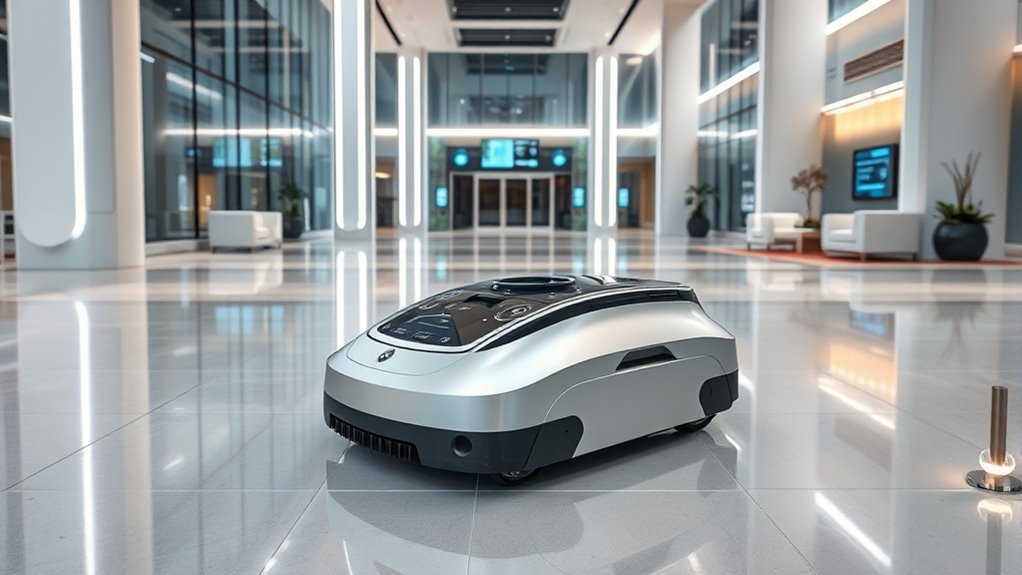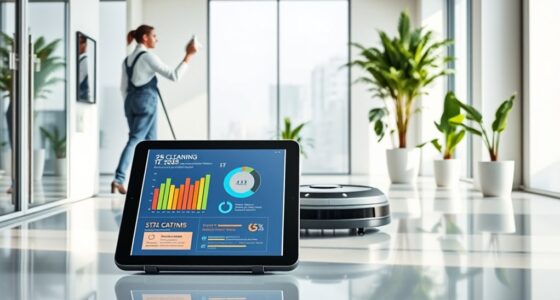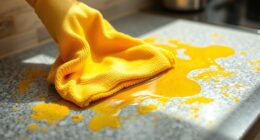In 2025, AI is transforming commercial cleaning robots by making them smarter and more efficient. They map spaces accurately, recognize obstacles, and optimize routes for quicker, more thorough cleaning. These robots learn your environment over time, reducing manual setup and intervention. With self-diagnosis capabilities and regular updates, maintenance is simpler and less frequent. Keep exploring to discover how AI continues to push cleaning technology forward, making your space cleaner and maintenance easier than ever.
Key Takeaways
- AI enables cleaning robots to map and adapt to complex commercial spaces for improved coverage and efficiency.
- Advanced sensors and AI diagnostics reduce maintenance needs and minimize downtime in busy environments.
- Self-learning algorithms optimize routes, avoiding obstacles and enhancing cleaning speed and thoroughness.
- Firmware updates and AI-driven troubleshooting ensure robots stay current with latest features and performance improvements.
- Integration of AI in commercial robots enhances productivity, reduces labor costs, and ensures consistent cleaning quality.

Cleaning robots have revolutionized the way you maintain your home by taking on the tedious task of sweeping, vacuuming, and mopping. This innovation isn’t just about convenience; it’s about smarter, more efficient cleaning processes driven by advanced AI algorithms. When it comes to robot maintenance, you’ll find that these devices are designed to be as low-maintenance as possible, but understanding how they operate helps you keep them running smoothly. Most modern cleaning robots use AI algorithms to map your space, recognize obstacles, and optimize cleaning routes. These algorithms learn over time, adapting to your home’s layout and your cleaning preferences, which means your robot becomes more efficient with each session.
Cleaning robots use AI to map spaces, recognize obstacles, and improve efficiency over time.
You don’t need to be tech-savvy to manage these devices, but a basic understanding of AI algorithms can help you troubleshoot minor issues. For example, if your robot gets stuck or misses spots, it might be due to a temporary glitch in its navigation system. Restarting the device or updating its software can often resolve these problems. Regularly cleaning the robot’s sensors and brushes also plays a vital role in maintenance, guaranteeing the AI algorithms have accurate data to work with. When sensors are dirty or obstructed, the robot’s ability to detect obstacles or avoid hazards diminishes, reducing cleaning efficiency. Additionally, familiarizing yourself with AI-driven features can help you maximize the benefits of your cleaning robot.
Many cleaning robots now come with self-diagnosis features powered by AI, which alert you to potential issues before they become serious. These alerts might notify you when the battery is low, or if the brushes need replacing, helping you maintain the device proactively. Staying updated with firmware updates is equally important, as manufacturers often improve AI algorithms to enhance navigation, obstacle detection, and cleaning performance. These updates ensure your robot remains at peak performance, adapting to new household changes or cleaning challenges.
In essence, the integration of AI algorithms into cleaning robots has made maintenance more straightforward and intuitive. You don’t need to manually program the device for every task; instead, the robot’s AI handles most of the heavy lifting by learning your environment. Proper robot maintenance, combined with understanding its AI-driven functions, assures your cleaning robot operates at its highest capacity. As these devices become more sophisticated, they’ll continue to learn from their environment, making your cleaning routine simpler, faster, and more effective in 2025.
Frequently Asked Questions
How Do Cleaning Robots Handle Difficult Stains?
You might wonder how cleaning robots handle tough stains. These robots use advanced AI for stain removal and deep cleaning, allowing them to identify difficult spots precisely. They adjust their scrubbing techniques and apply targeted cleaning solutions efficiently. With sensors and smart algorithms, they guarantee thorough deep cleaning, even on stubborn stains. This technology makes sure your spaces stay spotless without manual effort, delivering professional results every time.
What Is the Maintenance Cost for Cleaning Robots?
Think of your cleaning robot as a loyal companion, whose lifespan depends on regular care. Maintenance costs are like fuel for this journey—covering routine checks, software updates, and occasional parts replacement. On average, these costs stay manageable, but high-quality models may have higher initial prices and replacement costs. Proper upkeep guarantees your robot lasts longer, reducing overall expenses and keeping your cleaning partner ready for the next task.
Are Cleaning Robots Suitable for All Commercial Environments?
You might wonder if cleaning robots fit your commercial space, but their compatibility varies. While they excel in large, open areas, cleaning robot limitations include maneuvering tight spaces or handling delicate surfaces. Assess your environment’s layout and surface types to determine compatibility. Ultimately, understanding these factors helps you decide if a cleaning robot can meet your cleaning needs efficiently, or if manual cleaning remains necessary.
How Do Cleaning Robots Ensure Hygiene Standards?
You might think cleaning robots just sweep or vacuum, but they guarantee hygiene standards through touchless sanitization, which eliminates cross-contamination. AI-driven scheduling allows them to clean at ideal times, maintaining consistent hygiene. By constantly monitoring surfaces and adjusting their routines, these robots assure a thorough clean, reducing germs and bacteria effectively. This innovative approach keeps commercial environments safer and cleaner without human contact, ensuring high hygiene standards effortlessly.
Can Cleaning Robots Be Customized for Specific Cleaning Needs?
You can customize cleaning robots to meet your specific cleaning needs, ensuring ideal performance. Robot customization allows you to program tasks, set cleaning schedules, and adjust cleaning patterns based on your environment. This flexibility helps you target high-traffic areas, delicate surfaces, or specialized tasks. By tailoring your cleaning robots, you improve efficiency and hygiene standards, making sure your space stays spotless while addressing unique requirements effortlessly.
Conclusion
By 2025, AI-driven cleaning robots are transforming commercial spaces faster than you can say “jetpack.” You’ll find yourself marveling at how these devices, like futuristic custodians, seamlessly handle grime and clutter, freeing you for more important tasks. With advancements happening at warp speed, it’s clear that the future of cleaning isn’t just shiny floors but a smarter, more efficient world. Embrace the change—your office’s new robotic janitors are here to stay.










